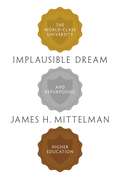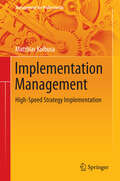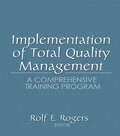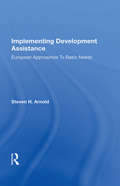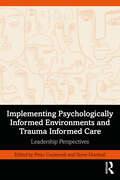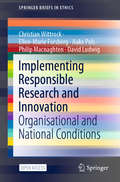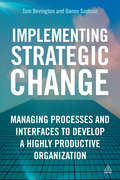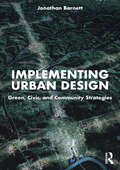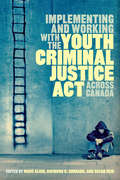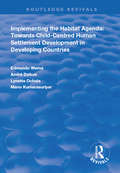- Table View
- List View
Implausible Beliefs: In the Bible, Astrology, and UFOs
by Allan MazurWhy do people accept ideas that are contradicted by science or logic? In Implausible Beliefs, Allan Mazur offers a comparative look at the nature of irrational belief systems, their social roots, and their cultural and political impact. He begins by providing standards for judging beliefs implausible and assessing the impact of such belief systems onpolitics and social policy in the US. Mazur describes and defends commonsense criteria for establishing that certain views should not be sustained in the face of present-day understanding. He presents a statistical portrait of implausible beliefs rampant in the US, and who tends to accept them.Mazur applies criteria for implausibility to the Bible, astrology, and visitation to Earth of intelligent beings from other worlds. Pointing out that everyone "knows" the Bible but few actually read it, the author scrolls through the first five books of the text, noting points that undermine the scripture's natural history and moral guidance. Working on the assumption that implausible religious views are fundamentally no different from implausible secular views, he critiques secular beliefs in astrology and UFOs. Mazur concludes the volume with an attempt to explain why most people accept implausibility‘some more than others despite evidence and logic that refute them.Looking to mainstream sociology and psychology, Mazur shows how children are socialized into such beliefs, and how adults are influenced by spouses and friends. Personality is also a factor, sometimes abetted by stressful or lonely life situations. Lucidly written, this is a provocative and informative contribution to social psychology, sociology, religion, political science, and American studies.
Implausible Dream: The World-Class University and Repurposing Higher Education
by James H. MittelmanWhy the paradigm of the world-class university is an implausible dream for most institutions of higher educationUniversities have become major actors on the global stage. Yet, as they strive to be “world-class,” institutions of higher education are shifting away from their core missions of cultivating democratic citizenship, fostering critical thinking, and safeguarding academic freedom. In the contest to raise their national and global profiles, universities are embracing a new form of utilitarianism, one that favors market power over academic values. In this book, James Mittelman explains why the world-class university is an implausible dream for most institutions and proposes viable alternatives that can help universities thrive in today’s competitive global environment.Mittelman traces how the scale, reach, and impact of higher-education institutions expanded exponentially in the post–World War II era, and how the market-led educational model became widespread. Drawing on his own groundbreaking fieldwork, he offers three case studies—the United States, which exemplifies market-oriented educational globalization; Finland, representative of the strong public sphere; and Uganda, a postcolonial country with a historically public but now increasingly private university system. Mittelman shows that the “world-class” paradigm is untenable for all but a small group of wealthy, research-intensive universities, primarily in the global North. Nevertheless, institutions without substantial material resources and in far different contexts continue to aspire to world-class stature.An urgent wake-up call, Implausible Dream argues that universities are repurposing at the peril of their high principles and recommends structural reforms that are more practical than the unrealistic worldwide measures of excellence prevalent today.
Implementation Management
by Matthias KolbusaCurrent technological, demographic and globalization trends are not only leading to intensified competition; they also indicate that new business models are rapidly emerging but only to disappear again just as quickly. Timely recognition of the new changes, jettisoning of old approaches and rapid implementation of the currently required changes within a company are now decisive competitive factors. Those who best survive (and thrive) in the future will be those who dramatically increase their success rate within this change process. Building on his best-selling book 'The Strategy Scout' Matthias Kolbusa explains the decisive principles in this rapidly changing business environment.
Implementation of Total Quality Management: A Comprehensive Training Program
by Erdener Kaynak Rolf E RogersHere is a comprehensive guide for training a workforce in Total Quality Management (TQM). An ideal resource for trainers, Total Quality Management Implementation contains a complete presentation of all relevant aspects of TQM. It provides a ready-made training format that can be used in all operational seminar/workshop contexts and includes a full set of charts for use by trainers in their presentations of TQM. The book assumes the trainer has a basic understanding of quality management, and it does not repeat the numerous discussions of TQM concepts readily available in other works.Total Quality Management Implementation begins with an overview of the current status of TQM in the United States. It then presents W. Edward Deming’s 14 point TQM philosophy, the core of his recommendations for achieving quality excellence through continuous improvement, along with a discussion of each point. The presentation charts have been designed to allow the trainer to adapt them to a particular organization’s unique characteristics and to supplement or add to them as necessary to fully explain each point to a particular audience. The charts are arranged in sequential order and follow the approach used by the author in training seminars around the world. Trainers can easily manipulate the length of the presentation for different audiences and purposes. A reference section lists many books on TQM principles which provide a helpful refresher.Total Quality Management Implementation is a unique and helpful guide for trainers with a basic knowledge of TQM, college or university faculty teaching TQM seminars or courses, and consultants and quality professionals who could use a reference and checklist of TQM principles.
Implementation of the Small-Scale Fisheries Guidelines: A Legal and Policy Scan (MARE Publication Series #28)
by Svein Jentoft Ratana Chuenpagdee Julia NakamuraThis book provides a transdisciplinary assessment of multiple countries’ legal and policy frameworks vis-à-vis the Voluntary Guidelines for Securing Sustainable Small-Scale Fisheries in the Context of Food Security and Poverty Eradication, adopted in 2014 by the Committee on Fisheries of the Food and Agriculture Organization of the United Nations. Based on an appraisal framework used to facilitate the unpacking of those frameworks, this book collects country experiences and regional perspectives on a range of cross-cutting issues underpinning the protection of the rights and the promotion of justice for small-scale fishers and their communities.This book aims to be the first collection to present a systematic and in-depth assessment of existing national legal and policy frameworks vis-à-vis the SSF Guidelines. This assessment is done through the transdisciplinary and collaborative work of researchers, governments, and civil society organizations for the analysis of the cross-thematic questions, which the contributors of this book aim to address. Firstly, what are the relevant laws and policies that matter for securing rights of small-scale fishers and their communities? How are small-scale fisheries defined by national laws and policies? How are small-scale fisheries treated (i.e., specifically or generally) in these instruments? Are there specific provisions and references to small-scale fisheries or any of its associated terminologies (e.g., artisanal, subsistence, traditional, indigenous)? Secondly, how the relevant instruments address the 8 small-scale fisheries key issues outlined in that rapid appraisal study? What are the strengths and gaps in these instruments? Do they address issues that are not covered by the SSF Guidelines? Do they contribute to clarifying other legal issues that are relevant for sustainable small-scale fisheries? Finally, since the book also aims to explore the accessibility of these legal and policy instruments for those to which they matter the most (the small-scale fishers), the following questions were also considered: What challenges do they face in knowing and understanding the relevant laws and policies in place? Which tools, measures and processes are available in the countries to ensure small-scale fishers can claim for their rights? To what extent judicial courts have recognized and/or granted rights to small-scale fishers?Chapters 11 and 20 are available open access under a Creative Commons Attribution 4.0 International License via link.springer.com.
Implementing Development Assistance: European Approaches To Basic Needs
by Steven H. ArnoldAlthough much has been written about development assistance to the Third World, nearly all the attention has focused on U.S. programs and policy. The important and growing commitment of European countries--which now collectively account for over half of all development assistance provided by the industrialized nations--has been virtually ignored. European nations, like the u.s., support in principle a “basic needs†focus in their assistance programs, but the strategies they employ reveal a variety of styles and technical approaches, many of which could be useful in improving U.S. aid programs. This study describes and analyzes the development assistance programs of the five major European donors: France, Germany, the Netherlands, the United Kingdom, and Sweden. Drawing on primary sources and interviews with representatives of the various assistance agencies and with outside experts, Dr. Arnold describes each country’s program in terms of three general areas: the evolution of its philosophy and overall policy goals, the organizational structure of the government institutions concerned with development assistance (including the relationship of these institutions to legislative and other policymaking bodies), and the content and procedures of the assistance programs.
Implementing Hoshin Kanri: How to Manage Strategy Through Policy Deployment and Continuous Improvement
by Anders Melander David Andersson Fredrik Elgh Fredrik Fjellstedt Malin LöfvingThis book focuses on the implementation of Hoshin Kanri. It is a response to most books on strategic planning that tend to downplay the implementation and only describe the fully implemented planning process. The power of this book originates from a project in which a team of five professionals over a period of three years implemented Hoshin Kanri in 14 companies; results were drawn from 130 workshops with leadership teams. The project team subsequently ran several accelerators inside large and small companies as well as public institutions. All these experiences together form the implementation focus of the book. Moreover, the organization of the book mirrors the message of its scientific thinking, which is also the basic principle of Hoshin Kanri: Chapter 1 focuses on the basic analysis—Is Hoshin Kanri something for your organization? Chapter 2 addresses the ambition—What is the vision for strategy work in your organization? Chapter 3 presents the conditions needed for effective strategic work. Chapter 4 discusses the choice of implementation strategy and your role as the change agent. Chapter 5 describes how Hoshin Kanri works when implemented. Chapter 6 addresses coaching/mentoring and the Kata philosophy. Chapter 7 presents important analytical tools. Appendix 1 describes the journey made by a medium-sized construction company. Essentially, this book describes in a concrete and structured way how you—the change agent—can use Hoshin Kanri in your organization to tackle large and complex challenges.
Implementing Lean: Twice the Output with Half the Input!
by Charles W. Protzman Daniel Protzman Fred WhitonEveryone has heard the phrase about doing twice the work in half the time, but instead of focusing only on time, this book focuses on driving increased output with consistently less input. Implementing Lean: Twice the Output with Half the Input! teaches readers not only about Lean and its major concepts, but it drives the leader toward implementing a true Lean system. The authors have used the methodologies in this book everywhere from hospitals to service industries to manufacturing plants in order to impact businesses by providing proven principles, techniques, and approaches that yield substantial improvement to any business, small or large, in any sector. Learn about the benefits of implementing Lean in your company as the authors walk you through the major components as well as show you how to implement them. This guide is already being used by Lean Practitioners every day on shop floors to educate and refresh how tools are used in real-world applications.
Implementing Psychologically Informed Environments and Trauma Informed Care: Leadership Perspectives
by Peter Cockersell Sione MarshallThis book gathers together the experiences of leaders across sectors, organisations and client groups to help readers introduce, develop, and maintain psychologically informed environments (PIE) and trauma informed care (TIC) within their workspaces.Featuring the voices of providers, commissioners, consultants, and trainers from the NHS, local authorities, and the voluntary sector, this unique text includes chapters on implementing PIE across a range of overlapping fields, including young people’s, homelessness, mental health, and women’s services. Each chapter describes the contributors’ experiences of which factors and processes enable or disable successful implementation of PIE/TIC; the unique challenges of leadership within this process; and how to understand the different dynamics at play in an organisation that determine effectiveness. With an emphasis on practical examples underpinned by theory, and recommendations drawn from the emergent themes, the book acts as an invitation for leaders to explore how they can influence the growth and evolving shape of PIE and trauma informed approaches across health and social care and support settings, and beyond.This book will be an invaluable resource for aspiring and new, as well as experienced, leaders who are interested in implementing and enabling PIE and TIC in their organisations.
Implementing Responsible Research and Innovation: Organisational and National Conditions (SpringerBriefs in Ethics)
by David Ludwig Ellen-Marie Forsberg Christian Wittrock Auke Pols Philip MacnaghtenThis open access book offers a unique and practically oriented study of organisational and national conditions for implementing Responsible Research Innovation (RRI) policies and practices. It gives the reader a thorough understanding of the different aspects of RRI, and of barriers and drivers of implementation of RRI related policies. It shows how different organisational and national contexts provide unique challenges and opportunities for bringing RRI into practice. The book provides concrete examples and offers the reader both a theory-based understanding of the topic, as well as guidance for action. The target audience encompasses, in addition to RRI students and scholars in particular, all students and scholars in the field of Science and Technology Studies (STS). The book is also of interest to students and scholars in the fields of research ethics, philosophy of science, organisational governance in the research system and organisational theory more generally. Finally, the book is of use to practitioners in research conducting and funding organisations working to implement RRI.
Implementing Strategic Change
by Tom Bevington Daniel SamsonOne of the key success factors for any organization is effective strategic change - to ensure adaptability and increase productivity. Despite its importance, most change management projects fail or only partly deliver on their promise. the missing link often being the conflict between boardroom strategic initiatives and the working process design of the company. Implementing Strategic Change shows that most of this conflict occurs during interfacing activity - the seemly small activities that help drive a process forward and can make up to 80% of many employees workload. Examples of interfacing activities include tasks like chasing, following up, seeking permission to proceed. Implementing Strategic Change will show that business strategy and change implementation rely on deep and close process knowledge and help develop the framework for understanding and improving these activities in any organization.
Implementing Strategic Change: Managing Processes and Interfaces to Develop a Highly Productive Organization
by Tom Bevington Daniel SamsonOne of the key success factors for any organization is effective strategic change - to ensure adaptability and increase productivity. Despite its importance, most change management projects fail or only partly deliver on their promise, the missing link often being the conflict between boardroom strategic initiatives and the working process design of the company. Implementing Strategic Change shows that most of this conflict occurs during interfacing activity - the seemly small activities such as chasing, following up and seeking permission to proceed that help drive a process forward can make up to 80% of many employees workload. This book will show that business strategy and change implementation rely on deep and close process knowledge and help develop the framework for understanding and improving these activities in any organization.
Implementing Sure Start Policy: Context, Networks and Discretion
by Xiongwei SongIn 1997, the Labour Government came to power in the UK and committed to reforming public service delivery, particularly towards the improvement of children’s services. This book analyses Labour Party’s subsequent strategy towards public service delivery emphasising, on one level, devolving more power to frontline deliverers, while on the other, strengthening central control through a variety of means, leading to a ‘mixed-approach’ in its overall reforms. The book focuses on the implementation process involved in rolling out its Sure Start policy in order to understand and analyse the dynamics in Labour’s approach to delivery. In so-doing, it draws on implementation and policy network theories to offer an original analytical framework - ‘the implementation network approach’ - to explain the implementation process of Sure Start policy. This book will be undoubtedly appealing to the students and scholars engaged in the fields of Public Policy and British Politics.
Implementing Urban Design: Green, Civic, and Community Strategies
by Jonathan BarnettImplementing Urban Design: Green, Civic, and Community Strategies addresses a central urban design issue: how to bring an urban design from concept to reality. When implementation strategies are made an integral part of urban design, the result becomes more detailed, more situational, and much more likely to be related to the natural landscape and the character already present in the community. The strategies described in this book range from neighborhoods to downtown business districts, and from designs for whole suburbs and cities to designs at the scale of the region and megaregion. They deal with everyday situations, although some of the issues can be complicated. This book will interest community leaders, urban design professionals, and the students, instructors, and practitioners of urban design and city planning.
Implementing and Working with the Youth Criminal Justice Act across Canada
by Marc Alain Susan Reid Raymond R. CorradoSince its implementation in 2003, the Youth Criminal Justice Act has been the subject of intense political and scholarly debate. A complicated mixture of provisions intended to provide harsher punishments for serious violent crimes while encouraging positive, non-punitive interventions in less serious cases, its impact on the youth justice system remains controversial.Implementing and Working with the Youth Criminal Justice Act across Canada provides the first comprehensive, province-by-province analysis of how each Canadian jurisdiction has implemented the Act in accordance with its own history, traditions, and institutional arrangements. Drawing on in-depth interviews with probation officers, counselors, educators, and social workers, the contributors use the experiences of practitioners to offer a new analytical perspective on a complicated and contentious aspect of the Canadian justice system. Their conclusions provide vital policy and program information for researchers, practitioners, and policy makers concerned with Canada's youth justice systems.
Implementing the Habit Agenda: Towards Child-centred Human Settlement Development in Developing Countries (Routledge Revivals)
by Edmundo Werna André Dzikus Lynette Ochola Mano KumarasuriyarPublished in 1999, this text provides a comprehensive view of the problematique of urban children in developing countries. It starts by demonstrating why it is important to address housing and settlement-related problems faced by the children in developing countries. The book emphasizes that the problematique under scrutiny is so vast that one could face strong difficulties in trying to implement a multitude of isolated/parallel projects and programmes to address a vast number of particular issues. The book demonstrates the existence of strong linkages between the particular issues analyzed. It suggests that a child-centred integrated approach constitutes a good priority for intervention. In terms of evaluation, one could also face difficulties if trying to devise an all-inclusive method for the whole developing world. The book therefore suggests that a simple set of general indicators for evaluation which have international approval should be used in conjunction with locally-constructed indicators.
Implications of Information and Digital Technologies for Development: 18th IFIP WG 9.4 International Conference, ICT4D 2024, Cape Town, South Africa, May 20–22, 2024, Proceedings, Part I (IFIP Advances in Information and Communication Technology #708)
by Salah Kabanda Wallace Chigona Lisa F. SeymourThis book constitutes the refereed proceedings of the 18th IFIP WG 9.4 International Conference on Implications of Information and Digital Technologies for Development, ICT4D 2024, which was held in Cape Town, South Africa, during May 20–22, 2024. The 49 full papers and 4 short papers presented were carefully reviewed and selected from 107 submissions. They are organized in topical sections as follows: Part I - Artificial Intelligence, Inequalities, and Human Rights; Digital Inclusion through e-Government; Giving Voice to Marginalised Perspectives in IS Research; Human-Computer Interaction for Ethical Value Exchange and Social Inclusion; ICT Curriculum and Education; ICT in Displacement and Conflict Zones: Ideas, Disconnects, & Innovations; Research in Indigenous African Languages; Smart Collaborations & Crowdsourcing; Technology & Social Justice. Part II - Diverse and Inclusive Digital Transformation; Information and Computer Security; General Track; Philosophical, Theoretical and Methodological Approaches to Researching ICT4D.
Implications of Information and Digital Technologies for Development: 18th IFIP WG 9.4 International Conference, ICT4D 2024, Cape Town, South Africa, May 20–22, 2024, Proceedings, Part II (IFIP Advances in Information and Communication Technology #709)
by Salah Kabanda Wallace Chigona Lisa F. SeymourThis book constitutes the refereed proceedings of the 18th IFIP WG 9.4 International Conference on Implications of Information and Digital Technologies for Development, ICT4D 2024, which was held in Cape Town, South Africa, during May 20–22, 2024. The 48 full papers and 4 short papers presented were carefully reviewed and selected from 107 submissions. They are organized in topical sections as follows: Part I - Artificial Intelligence, Inequalities, and Human Rights; Digital Inclusion through e-Government; Giving Voice to Marginalised Perspectives in IS Research; Human-Computer Interaction for Ethical Value Exchange and Social Inclusion; ICT Curriculum and Education; ICT in Displacement and Conflict Zones: Ideas, Disconnects, & Innovations; Research in Indigenous African Languages; Smart Collaborations & Crowdsourcing; Technology & Social Justice. Part II - Diverse and Inclusive Digital Transformation; Information and Computer Security; General Track; Philosophical, Theoretical and Methodological Approaches to Researching ICT4D.
Implicit Measures for Social and Personality Psychology (The SAGE Library of Methods in Social and Personality Psychology)
by Laurie A. RudmanIncreasingly used by behavioural and social scientists, implicit measures afford investigating core psychological constructs in ways that bypass people's willingness and ability to report their feelings and beliefs. Focused on two primary assessment tools, evaluative priming and the Implicit Association Test, the Implicit Measures volume is designed for serious practitioners and beginning researchers alike. It provides an overview of each measure, describing its theoretical underpinnings and construct validity. Each chapter then lays out "best practices" for successfully designing each method and analyzing results, revealing how to avoid common pitfalls. The Implicit Measures volume will enable students of implicit measures to decide when and how to use them in their own research, and educate consumers of research about the accomplishments and challenges of using these state-of-the art assessment techniques.<P><P> The SAGE Library in Social and Personality Psychology Methods provides students and researchers with an understanding of the methods and techniques essential to conducting cutting-edge research. <P> Each volume within the Library explains a specific topic and has been written by an active scholar (or scholars) with expertise in that particular methodological domain. Assuming no prior knowledge of the topic, the volumes are clear and accessible for all readers. In each volume, a topic is introduced, applications are discussed, and readers are led step by step through worked examples. In addition, advice about how to interpret and prepare results for publication are presented.
Impoliteness
by Jonathan CulpeperWhen is language considered 'impolite'? Is impolite language only used for anti-social purposes? Can impolite language be creative? What is the difference between 'impoliteness' and 'rudeness'? Grounded in naturally-occurring language data and drawing on findings from linguistic pragmatics and social psychology, Jonathan Culpeper provides a fascinating account of how impolite behaviour works. He examines not only its forms and functions but also people's understandings of it in both public and private contexts. He reveals, for example, the emotional consequences of impoliteness, how it shapes and is shaped by contexts, and how it is sometimes institutionalised. This book offers penetrating insights into a hitherto neglected and poorly understood phenomenon. It will be welcomed by students and researchers in linguistics and social psychology in particular.
Importing Care, Faithful Service: Filipino and Indian American Nurses at a Veterans Hospital (Critical Issues in Health and Medicine)
by Stephen M. CherryEvery year thousands of foreign-born Filipino and Indian nurses immigrate to the United States. Despite being well trained and desperately needed, they enter the country at a time, not unlike the past, when the American social and political climate is once again increasingly unwelcoming to them as immigrants. Drawing on rich ethnographic and survey data, collected over a four-year period, this study explores the role Catholicism plays in shaping the professional and community lives of foreign-born Filipino and Indian American nurses in the face of these challenges, while working at a Veterans hospital. Their stories provide unique insights into the often-unseen roles race, religion and gender play in the daily lives of new immigrants employed in American healthcare. In many ways, these nurses find themselves foreign in more ways than just their nativity. Seeing nursing as a religious calling, they care for their patients, both at the hospital and in the wider community, with a sense of divine purpose but must also confront the cultural tensions and disconnects between how they were raised and trained in another country and the legal separation of church and state. How they cope with and engage these tensions and disconnects plays an important role in not only shaping how they see themselves as Catholic nurses but their place in the new American story.
Impossible Refuge: The Control and Constraint of Refugee Futures (On Edge: Ethnographies and Theories of Threshold Phenomena)
by Georgina RamsayImpossible Refuge brings the perspectives of refugees into rapidly emerging dialogues about contemporary situations of mass forced migration, asking: what does it mean to be displaced? Based on multi-sited ethnographic research conducted with refugees from Central Africa living in situations of protracted asylum in Uganda and resettlement in Australia, the book provides a unique comparative analysis of global humanitarian systems and the experiences of refugees whose lives are interwoven with them. The book problematises the solutions that are currently in place to resolve the displacement of refugees, considering that since displacement cannot be reduced to a politico-legal problem but is an experience that resonates at an existential level, it cannot be assumed that politico-legal solutions to displacement automatically resolve what is, fundamentally, an existential state of being. Impossible Refuge therefore offers a new theoretical foundation through which to think about the experiences of refugees, as well as the systems in place to manage and resolve their displacement. The book argues that the refuge provided to refugees through international humanitarian systems is conditional: requiring that they conform to lifestyles that benefit the hegemonic future horizons of the societies that host and receive them. Impossible Refuge calls for new ways of approaching displacement that go beyond the exceptionality of refugee experience, to consider instead how the contestation and control of possible futures makes displacement a general condition of our time. As such, it will appeal to scholars across the social sciences with interests in migration and refugees, humanitarianism and violence, sovereignty and citizenship, cosmology and temporality, and African studies, broadly.
Impoverishment and Asylum: Social Policy as Slow Violence (Routledge Advances in Sociology)
by Lucy MayblinImpoverishment and Asylum argues that a shift has taken place in recent decades from construing asylum as primarily a political and/or humanitarian phenomenon, to construing it as primarily an economic phenomenon, and that this shift has had led to the purposeful impoverishment, by the state, of people seeking asylum in the UK. This shift has had far-reaching consequences for people seeking asylum, who have been systematically impoverished as part of the effort to strip out any possibility of an economic pull factor leading to more arrivals, but also for those administering their support system, and for civil society organisations and groups who seek to ameliorate the worst effects of the resulting asylum regimes. This book argues that within this context asylum support policies in the UK which are meant to help and protect, in fact do serious harm to their recipients. It argues that the shift from construing asylum seekers as economically, rather than politically, motivated migrants across the West, is part of a much broader set of historical and philosophical worldviews than has previously been articulated. The book offers a rigorously researched and richly theorised analysis drawing on postcolonial and decolonial perspectives in making sense of the purposeful impoverishment by the state of a particular group of people, and why this continues to be tolerated in the fourth richest country in the world.
Impression Management in the Workplace: Research, Theory and Practice
by Andrew J. DuBrinWanting to create a favorable impression with others is a basic part of human nature in both work and personal life. In this book, Andrew J. DuBrin skillfully provides a guide to the effective use of impression management based on scholarly research and theory, with particular attention to practical application. He highlights not only impressions that individuals make, but those made by entire organizations. Self-tests and questionnaires allow readers to pinpoint how they currently employ impression management techniques in their work lives. Each chapter includes a section on "Guidelines for Application and Skill Development" that provides real-world advice based on the theories and research outlined in the chapter. With this book, students will glean the best methods for creating positive, career-building impressions in current and future positions.
Impressionable Biologies: From the Archaeology of Plasticity to the Sociology of Epigenetics
by Maurizio MeloniDuring the twentieth century, genes were considered the controlling force of life processes, and the transfer of DNA the definitive explanation for biological heredity. Such views shaped the politics of human heredity: in the eugenic era, controlling heredity meant intervening in the distribution of "good" and "bad" genes. However, since the turn of the twenty-first century, this centrality of genes has been challenged by a number of "postgenomic" disciplines. The rise of epigenetics in particular signals a shift from notions of biological fixedness to ideas of plasticity and "impressionability" of biological material. This book investigates a long history of the beliefs about the plasticity of human biology, starting with ancient medicine, and analyses the biopolitical techniques required to govern such permeability. It looks at the emergence of the modern body of biomedicine as a necessary displacement or possibly reconfiguration of earlier plastic views. Finally, it analyses the returning of plasticity to contemporary postgenomic views and argues that postgenomic plasticity is neither a modernistic plasticity of instrumental management of the body nor a postmodernist celebration of potentialities. It is instead a plasticity that disrupts clear boundaries between openness and determination, individual and community, with important implications for notions of risk, responsibility and intervention.

